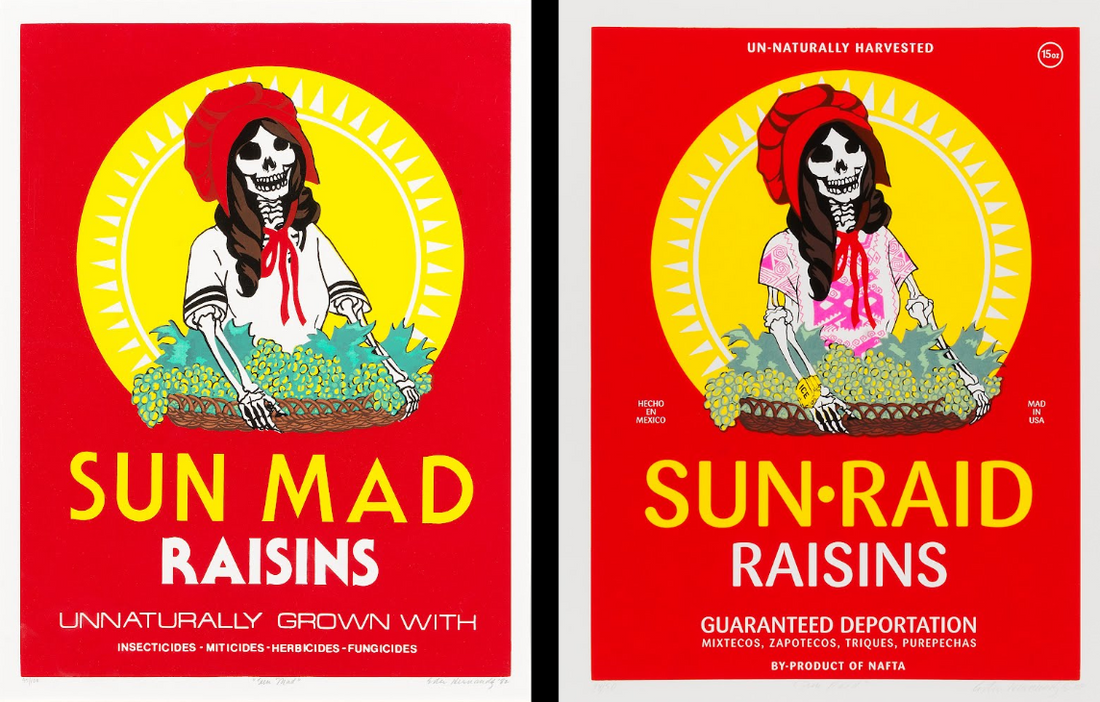Featured image: Sun Mad and Sun Raid (1982; 2008) Ester Hernandez
Understanding the difference between cultural appropriation and cultural appreciation is crucial in today's globalized society.
There is a fine line between cultural appropriation and appreciation in art.
This distinction plays a significant role in art, where the line can sometimes blur, leading to controversies and misunderstandings about the use of cultural elements.
Explore our curated selection of contemporary artists from around the globe.
Naturalist Gallery offers artist representation internationally. Apply your art.
Defining the Concepts
Irony of Negro Policeman (1981) Jean-Michel Basquiat
- Cultural Appropriation: This occurs when elements of a culture are taken and used by another culture, particularly by dominant groups from minority groups, without understanding, acknowledgment, or respect for their significance. This often leads to the commodification and decontextualization of these cultural elements.
The Swing (After Fargonard) (2001) Yinka Shonibare CBE RA
- Cultural Appreciation: In contrast, cultural appreciation involves engaging with a culture in a respectful and informed manner, understanding the significance of its elements, and acknowledging the source culture. This includes respecting cultural boundaries and ensuring mutual benefit and acknowledgment.
Spirit of the Dead Watching (1892) Paul Gauguin
Historical Context Cultural appropriation in art is not new. Historically, European colonialism has played a significant role in appropriating motifs and styles from non-Western cultures, often representing them as exotic or primitive. This trend has continued through various cultural movements, including the Harlem Renaissance and the mid-20th-century bohemian culture.
Examples in Modern Context
Adaptation II (2012) Jamie Okuma
- Fashion and music festivals often see non-native individuals wearing Native American headdresses or African American hairstyles like cornrows, which have deep cultural and historical significance, as mere fashion statements.
Liberation of Aunt Jemimah (1972) Betye Saar
- The commercialization of cultural symbols and practices, such as the inappropriate use of sacred Native American symbols or the "trendy" adoption of hairstyles integral to Black culture, represents a lack of understanding and respect for the original cultural contexts.
Mining the Museum (1992-1993) Fred Wilson
Impact on Communities The impact of cultural appropriation extends beyond just feelings of disrespect; it can lead to economic exploitation and perpetuate stereotypes and systemic inequalities. When cultural elements are commodified without benefiting the origin communities, it contributes to ongoing disparities and erodes the cultural heritage.
The Dinner Party (1979) Judy Chicago
Navigating Cultural Engagement Engaging with different cultures requires:
- Informed Understanding: Learning about the history and significance of the cultural elements.
- Respect for Cultural Boundaries: Acknowledging that some cultural aspects are not meant for outsider participation.
- Mutual Benefit: Ensuring that cultural exchanges benefit both the source community and the user, with proper credit and compensation.
Who's Afraid of Aunt Jemimah? (1983) Faith Ringgold
Artists and cultural consumers should strive for appreciation over appropriation by educating themselves about the cultures they engage with and ensuring their interactions are respectful and reciprocal.
Learn more About Naturalist Gallery of Contemporary Art.
You may also find the following articles helpful:
The 14 Essential Artists of Impressionism
Expressionism: 20 Iconic Paintings & Their Artists
Renaissance Art: Origins, Influences, and Key Figures
Classical Art Movement: Exploring the History, Artists, and Artworks
Figurative Art: Understanding, Collecting, and Appreciating the Style
Daily Routines of Famous Artists: Learn from the Masters
Top 12 Controversial Artworks That Changed Art History










